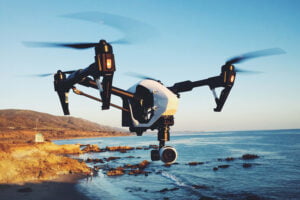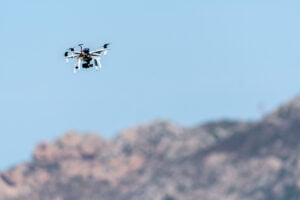 Every angler is looking for a way to get a leg up on the competition (I mean the fish). One interesting way to do this is with drone fishing. It’s a somewhat complicated way to get a more precise cast, and for many, it might seem like more work than it’s worth. If you’ve never heard of drone fishing or you don’t understand how it would work, stick around and see if a drone is what you’ve been missing all along.
Every angler is looking for a way to get a leg up on the competition (I mean the fish). One interesting way to do this is with drone fishing. It’s a somewhat complicated way to get a more precise cast, and for many, it might seem like more work than it’s worth. If you’ve never heard of drone fishing or you don’t understand how it would work, stick around and see if a drone is what you’ve been missing all along.
What is Drone Fishing?
Drone fishing is the act of using a remote-controlled aerial device to help pinpoint the ideal casting location and then drop your lure right where you want it.
People use drones for two different things when it comes to fishing:
- Scope out areas you might not be able to reach by boat
- Drop your lure right in that spot using a release mechanism
How Does Drone Fishing Work?

Essentially what you’re doing is flying a drone with a camera to a spot that looks like a great place to fish but, you can’t get there for a variety of reasons. Maybe it’s too shallow, too weedy, it seems risky, or you don’t have a boat at all and you’re fishing from the shore.
Once you find that spot, now what?
You got your ideal fishing location, now you’ll rig the drone using a tension release mechanism. Some are complicated while others are simple. It’s a clip that will release the line once you close the bail on the reel. We’ll get into this in more detail shortly.
When the line is released, it will drop your lure right into the spot where you want to fish and all is fine and dandy. Until you have to retrieve it.
As you can tell there are some flaws to this but there are dedicated fishing drones on the market that are designed specifically for this purpose. They’re waterproof, load-bearing, and capable of actually dropping your line and helping with the retrieval of a fish as well.
Head over to yourbassguy.com/best/fishing-drone/ to read my review of these drones based on specifications, features, and more.
The problem is, most of the drones you’ll use for fishing don’t come with that type of technology so you need to know how to rig them yourself. You won’t be able to retrieve a fish with it, but you can still scope the area and cast.
I think the technology hasn’t caught up yet so many manufacturers haven’t figured out a way to make a drone powerful and efficient enough to carry weight while also running for hours at a time.
How to Rig a Drone for Bass Fishing
When it comes to rigging your drone for fishing purposes, you have a few different methods. No matter what your strategy is, you need a lure release device that will clip onto your line so the drone can fly it out to your ideal spot.
Then, when you’re ready to drop it, you’ll close the bail, fly a little further out, and the clip will release and drop your lure into the water. Here’s some of the methods you can use.
Improvised Tension Release
For this, you’ll use a down-rigger payload release clip on your line and then fly the drone until you reach your location. This doesn’t require you to go out and purchase any expensive hardware and you can do it with a variety of drones as long as they’re powerful enough to pull the line.
Third-Party Mechanism
If you’re okay with spending a little money you can purchase a release mechanism for your drone. Many are for sale on Amazon and they function in the same way. You’ll clip your line, open the bail, fly out to your spot, close the bail, fly until you trigger the release, and you’re good to go.
Keep in mind that you’re not actually fishing with a drone, you’re using the drone to assist you in fishing. They sell fishing drones that are geared for this but as I mentioned, I wouldn’t buy them because I think they’re still in the prototype phase.
Drone Fishing Rules and The Ethics Behind it
As you’re sitting over there all excited about buying a drone to fish, I have to kill your buzz a little because there are a lot of rules and regulations that go into this. Recreational drone users must abide by the following rules:
- The drone must be registered and marked
- You can only fish for recreational purposes
- You cannot fly higher than 400 feet
- The drone must remain in your visible line of sight
- You cannot fly at night without proper lighting

Check out www.faa.gov/uas/recreational_fliers/ for more information about recreational flying. I’m sure you know you must also possess authorization before flying and you’re required to possess the proper pilot license in your state.
The preparation isn’t too bad and flying drones is a lot of fun but there’s also an ethical aspect to this. Fishing with drones offers us an advantage that we shouldn’t have.
It increases the efficiency of your casting accuracy which can lead to over-exploitation. We’re only in the beginning stages of technology reaching amateur fishermen but what happens in 50 years when fishing isn’t even a sport anymore because it’s so simple?
Anyone with enough money can go out and buy a $1,500 fish finder and a $1,000 drone and catch anything they want because the technology is overpowering. It takes some of the fun out of it if you ask me.
Part of the thrill of fishing is going to the lake not knowing if you’ll catch anything or not. Experimenting with lures, trying different reels, fishing in unique locations, and testing out different times and weather patterns. That’s a more primitive way of fishing and one that I hold near and dear to my heart.
The day that we drop our boat in the water and know exactly what we’ll catch and how many is the day that the sport of fishing dies.
Author: Coty Perry yourbassguy.com

